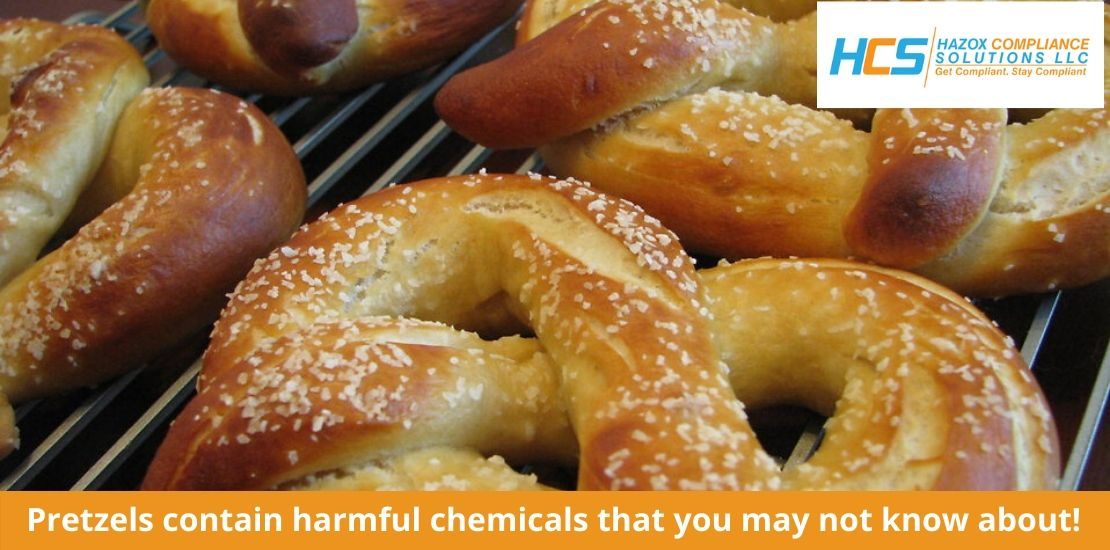- February 20, 2020
- Posted by: admin
- Category: Blogs

You’re settled in for the night, a good movie is cued up on the screen, you’re searching your pantry for a snack and that’s when you see it – that unopened bag of golden-brown goodness. For many of us, pretzels are a go-to snack – but did you know that the high-temperature baking process that makes them brown and crispy, creates a harmful chemical, acrylamide, that has been linked to cancer? Each year, the FDA conducts a survey of individual food products for acrylamide and these results are published for consumers to review (https://www.fda.gov/food/chemicals/survey-data-acrylamide-food-individual-food-products).
We, at Hazox, have created a campaign to let you know of harmful chemicals in your food that you may not be aware of. In the first issue, we looked at what acrylamide is. If you have missed the first in the series, you can catch up here (https://www.hazoxinc.com/potato-chips-contain-harmful-chemicals-that-you-may-not-know-about).
In this second article about acrylamides, we will look at which foods contain high amounts of acrylamides.
What foods contain acrylamide?
As discussed in the previous issue, acrylamide is a potentially toxic and carcinogenic substance that can be naturally present in raw foods in very small amounts. However, for this substance to pose a risk of toxicity or cancer, it must be present in food in much greater amounts, which are achieved by exposing the food to high temperatures.
The presence of acrylamide in some heat-treated foods poses a food safety problem because this compound is a neurotoxin and possible carcinogen in humans, so it is important to eliminate it or keep its level as low as possible. Food products with higher acrylamide content per serving include potato chips, breakfast cereals, cookies, roasted bean-based coffee substitutes and oxidized black olives.
Some of these seem surprising, especially olives. Research into their acrylamide content has shown some inconsistency in recent years, and this has led to controversy in the public press about their health risks. In data collected by the United States Food and Drug Administration (FDA), we have seen more than a dozen different types of olives that were determined not to contain any detectable level of acrylamide. However, some brands of canned olives have also been observed with very high levels. Based on this data, it is estimated that the high levels are related to the specific handling, storage, processing and heating steps that have encouraged acrylamide formation.
At present, no foolproof method is available to prevent consumers from buying canned black olives containing high amounts of acrylamide. Since the FDA data has not shown detectable levels of acrylamide in many brine-packed olives samples, it may be worth considering these olives as options that can help prevent unwanted acrylamide intake. In addition, extra virgin olive oil is another form of this nutrient-rich food that has been shown in research not to contain unwanted amounts of acrylamide.
The WHO, FDA and other organizations make recommendations to the manufacturers of the products evaluated, to reduce the levels of this toxic in their composition as much as possible, as a preventive measure.
Tomorrow we will return with more details about how acrylamide forms in food and what preparation methods we can use to reduce exposure to these toxic substances and achieve better health.
If you liked our article, please give us a Like and follow us on
Facebook: https://www.facebook.com/HazoxComplianceSolutions
Twitter: https://twitter.com/Hazox_Inc
LinkedIn: https://www.linkedin.com/company/hazoxcompliancesolutions
Youtube: https://www.youtube.com/channel/UCIeBucyOUEtQFSAymS3TwQQ
At Hazox, we believe that consumers should be aware of the hazardous chemicals used in everyday products to make informed choices before buying the products we need.
